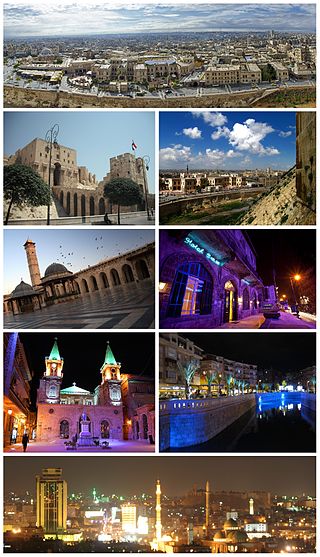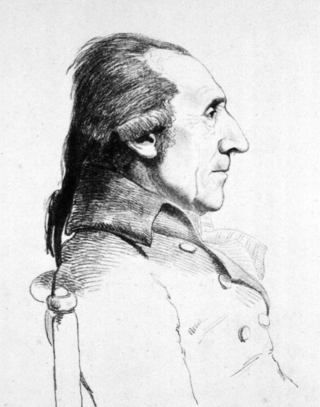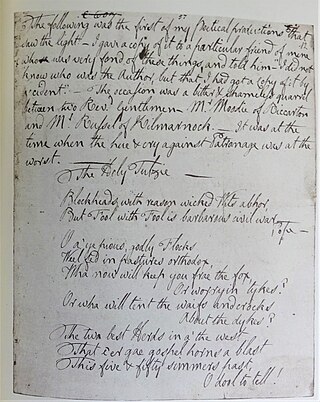
Year 1124 (MCXXIV) was a leap year starting on Tuesday of the Julian calendar, the 1124th year of the Common Era (CE) and Anno Domini (AD) designations, the 124th year of the 2nd millennium, the 24th year of the 12th century, and the 5th year of the 1120s decade.

Aleppo is a city in Syria, which serves as the capital of the Aleppo Governorate, the most populous governorate of Syria. With an estimated population of 2,098,000 residents as of 2021, it was Syria's largest city until its population was surpassed by Damascus, the capital of Syria, the largest in Syria's northern governorates and also one of the largest cities in the Levant region.
Alexander Neckam was an English poet, theologian, and writer. He was an abbot of Cirencester Abbey from 1213 until his death.

The golden hamster or Syrian hamster is a rodent belonging to the hamster subfamily, Cricetinae. Their natural geographical range is in an arid region of northern Syria and southern Turkey. Their numbers have been declining in the wild due to a loss of habitat from agriculture and deliberate elimination by humans. Thus, wild golden hamsters are now considered endangered by the International Union for Conservation of Nature. However, captive breeding programs are well established, and captive-bred golden hamsters are often kept as small house pets. They are also used as scientific research animals.

The Aleppo Codex is a medieval bound manuscript of the Hebrew Bible. The codex was written in the city of Tiberias in the tenth century CE under the rule of the Abbasid Caliphate, and was endorsed for its accuracy by Maimonides. Together with the Leningrad Codex, it contains the Aaron ben Moses ben Asher Masoretic Text tradition.

John Howie was a Scottish biographer. His best known work was Biographia Scoticana, first published in 1775, which is often called The Scots Worthies. It deals with Christians and particularly Presbyterians especially in their strivings with church and civil authorities.

Starting in the 1240s, the Mongols made repeated invasions of Syria or attempts thereof. Most failed, but they did have some success in 1260 and 1300, capturing Aleppo and Damascus and destroying the Ayyubid dynasty. The Mongols were forced to retreat within months each time by other forces in the area, primarily the Egyptian Mamluks. The post-1260 conflict has been described as the Mamluk–Ilkhanid War.

Patrick Russell was a Scottish surgeon and naturalist who worked in India. He studied the snakes of India and is considered the "Father of Indian Ophiology". Russell's viper, Daboia russelii, is named after him.

Syrian Jews are Jews who live in the region of the modern state of Syria, and their descendants born outside Syria. Syrian Jews derive their origin from two groups: from the Jews who inhabited the region of today's Syria from ancient times, and sometimes classified as Mizrahi Jews ; and from the Sephardi Jews who fled to Syria after the Alhambra Decree forced the expulsion of the Jews from Spain in 1492.

'Abd al-Rahman al-Kawakibi was a Syrian author and Pan-Arab solidarity supporter. He was one of the most prominent intellectuals of his time; however, his thoughts and writings continue to be relevant to the issues of Islamic identity and Pan-Arabism. His criticisms of the Ottoman Empire eventually led to Arabs calling for the sovereignty of the Arab Nations, setting the basis for Pan-Arab nationalism. Al-Kawakibi articulated his ideas in two influential books, The nature of tyranny and the struggle against slavery and Mother of All Villages. He died in 1902 of “mysterious” causes. His family alleged that he was poisoned by Turkish agents.

Bab al-Jinan, meaning the Gate of Gardens, was one of the gates of Aleppo that used to lead to gardens on the banks of the Quwēq river.
Syrian literature is modern fiction written or orally performed in Arabic by writers from Syria since the independence of the Syrian Arab Republic in 1946. It is part of the historically and geographically wider Arabic literature. Literary works by Syrian authors in the historical region of Syria since the Umayyad era are considered general Arabic literature. In its historical development since the beginnings of compilations of the Quran in the 7th century and later written records, the Arabic language has been considered a geographically comprehensive, standardized written language due to the religious or literary works written in classical Arabic. This sometimes differs considerably from the individual regionally spoken variants, such as Syrian, Egyptian or Moroccan spoken forms of Arabic.
The Near East earthquakes of 1759 were a series of devastating earthquakes that shook a large portion of the Levant in October and November of that year. This geographical crossroads in the Eastern Mediterranean were at the time under the rule of the Ottoman Empire. The ruins of Baalbek, a settlement in the Beqaa Valley of Lebanon east of the Litani River, were badly damaged. These 1759 events, along with the earlier 1202 Syria earthquake, are likely the strongest historical earthquakes in the region.

The 1947 anti-Jewish riots in Aleppo were an attack on Syrian Jews in Aleppo, Syria in December 1947, following the United Nations vote in favour of partitioning British Palestine. The attack, a part of an anti-Jewish wave of unrest across the Middle East and North Africa, resulted in some 75 Jews murdered and several hundred wounded. In the aftermath of the riots, half the city's Jewish population fled the city.

Alexander Russell was a Scottish physician and naturalist, spending 14 years at the English factory in Aleppo.
The following is a timeline of the history of the city of Aleppo, Syria.

Syria or Sham is a historical region located east of the Mediterranean Sea in West Asia, broadly synonymous with the Levant. Other synonyms are Greater Syria or Syria-Palestine. The region boundaries have changed throughout history. However, in modern times, the term "Syria" alone is used to refer to the Syrian Arab Republic.
Maurits Hubrecht van den Boogert is a Dutch writer on Ottoman history from about 1700-1900. He studied Orientalism at Leiden University, obtaining his PhD in 2001, and was a researcher in Ottoman history at that institute.

The domestication of the Syrian hamster began in the late 1700s when naturalists cataloged the Syrian hamster, also known as Mesocricetus auratus or the golden hamster. In 1930 medical researchers captured Syrian hamster breeding stock for animal testing. Further domestication led this animal to become a popular pet.

'The Holy Tulzie', 'The Twa Herds' or 'An Unco Mournfu' Tale was a poem written in 1784 by Robert Burns whilst living at Mossgiel, Mauchline, about a strong disagreement, not on doctrine, but on the parish boundaries, between two 'Auld Licht' ministers, John Russel and Alexander Moodie It was followed by "The Holy Fair", "The Ordination", "The Kirk's Alarm", "Holy Willie's Prayer", etc.















